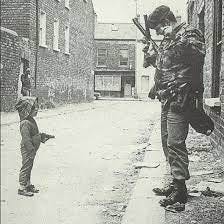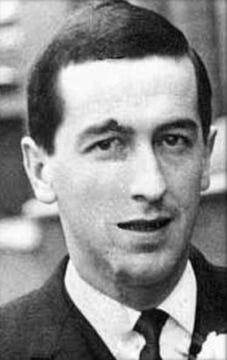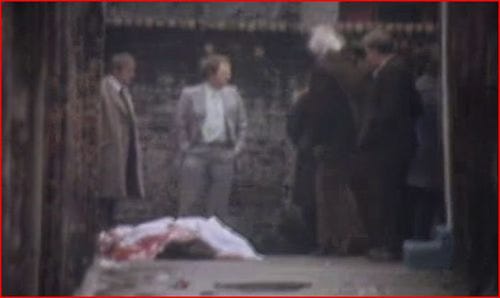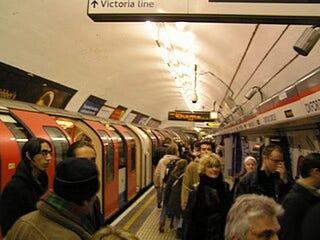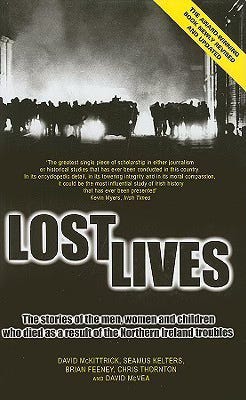February 1976: Shankill Butchers
February 1976 saw the premiere of the hit movie “Taxi Driver”, starring Robert DeNiro and directed by Martin Scorsese. The movie follows a mentally unstable veteran who works as a taxi driver in New York City. In Northern Ireland, some other mentally unstable individuals were abducting innocent civilians and torturing them, before murdering them. They became known as the Shankill Butchers.
Political Developments in February 1976
February began with the Constitutional Convention reconvening in an attempt to reach an agreement on a constitutional arrangement for Northern Ireland. A series of inter-party talks were held over the next three weeks and Robert Lowry chaired these.
On the 12th of February, Frank Stagg, a member of the IRA, died after 61 days on hunger strike in Wakefield Prison, Yorkshire, England. Stagg had been on hunger strike in protest at the British government's refusal to transfer him to a prison in Northern Ireland.
On the same day, talks between the UUUC and the SDLP broke down after only an hour. The UUUC would not agree to SDLP involvement in any future Northern Ireland cabinet. This was a key element as far as Merlyn Rees was concerned. The final meeting of the Convention took place on the 3rd of March 1976. The British government brought the Convention to an end on the 5th of March 1976.
There were riots in Belfast and Derry on the 13th of February following the news of the death of the IRA hunger striker Frank Stagg.
The Principal Medical Officer at the Department of Health and Social Services sent a memorandum on the 27th of February on the topic of mass hunger/thirst strikes. It read;
Mass Hunger Strikes, in the past, have been commenced by the initial action of a few prisoners generally 10 - 20 with the addition of a further 5 - 6 each day. By this method in a comparatively short time Prison Medical Staff generally find themselves embarrassed by the sheer numbers requiring daily medical checks in addition to those requesting attention on Sick Parade. A fact that this latter figure usually increases at the same time is not to be wondered at as the general purpose of mass food/fluid refusal is to embarrass and disrupt Prison Services (Medical and Administrative) to the greatest possible extent. However these "strikes" have usually occurred in pursuance of one grievance or another, and judging by the fact that these grievances have always been resolved after a comparatively short lapse of time, I have always been tempted to think that the "strike action" was initiated or should I say "timed" as to create maximum inconvenience with a minimum risk to those taking part.
However, on the approach of the date where after special category will no longer be granted to prisoners, it is certain that some disruptive action will be taken by those prisoners already holding special category and also by those to whom it is refused. This will very likely take the form of, or include, mass refusal of food and possibly of fluid. Whether or not the recent death of Prisoner Stagg will be any deterrent is a matter for conjecture but plans for dealing with such a demonstration must be drawn up.
Prison Medical Officers have already been notified by SMO Circular Letter of 19/07/74 of the policy regarding the artificial feeding of hunger strikers and the management of hunger strikers in general. A copy of the CMO’s letter of 19/07/74 is appended.
In the case of Mass Hunger Strikes, it is recommended that;
(a) In Cellular Prisons, strikers remain in their locations, and
(b) In Compound Prisons, strikers remain in their Compounds.
Health and general physical condition permitting.
In the event of the Strike Action being prolonged - generally by a small determined number - to the stage when progressive weight loss is established, together with persistent Ketonuria and evident signs of dehydration, these prisoners should be transferred;
(a) to the Prison Hospital for more frequent monitoring of their condition. This stage may be expected towards the end of the first week if those concerned are genuinely on hunger strike.
(b) to a National Health Service Hospital, should these signs become more pronounced and are accompanied by;
(i) Falling Blood Pressure
(ii) Postural Hypotension
(iii) Rising Pulse Rate
(iv) Decreasing Urinary output
(v) Increasing dehydration
This stage may be anticipated at or about the end of the 3rd - 4th week.
They will be transferred to the National Health Service Hospital for expert observation rather than treatment by Consultants, the Consultants being free
to offer expert advice and the prisoners being equally free to accept or refuse this advice, as they may wish. This point should be stressed to strikers at an early stage, ie, on their transfer to the Prison Hospital, but certainly, before cerebration is likely to become impaired.
(a) In the case of Compound Prisoners, should the Prison Hospital be unable to accommodate those requiring admission, as at 5(a) above, it may be necessary to equip a special compound for their accommodation (ie, a compound no longer in use for pure accommodation purposes).
(b) In the case of Cellular Prisons, eg, Belfast Prison where Hospital patient accommodation is severely restricted, it may be necessary to transfer such prisoners to the nearest Compound Prison where accommodation is more likely to be available - possibly Maze Prison.
Where fluid refusal is allied to food refusal, the onset of signs of deterioration are much more rapid and may be expected within days - a prominent sign being the inability to maintain cerebration for any period beyond a few minutes at a time.
(a) It is essential that prisoners embarking on Hunger/Thirst Strike be fully documented;
(i) as regards their Confidential Medical Records, using Forms IMR 7 and 8.
(ii) as regards daily notification to this Department, using the prescribed forms.
(b) As part of the procedure of warning strikers of the inherent dangers of their action, Medical Officers should stress the additional dangers in relation to known pre-existing medical conditions from which some may be already "at risk" eg, Renal Disease, Peptic and Duodenal Ulcer, Diabetes, etc.
Should extra beds and allied equipment be required, eg, Compound-type Prisons where recreational or other compounds are pressed into service, this can be arranged at short notice on application to this Department.
The various stages of management may be set out diagrammatically as attached.
Shootings, Stabbings & Beatings in February 1976
06/02/76 - Royal Ulster Constabulary officers James Blakely (42) and William Murtagh (31) were shot dead by the Irish Republican Army (IRA) at Cliftonville Circus, Belfast.
06/02/76 - Protestant civilian John McCready (57) died ten days after being shot by Republicans in Belfast.
07/02/76 - Civilian Thomas Quinn (55) was abducted while walking along Millfield, Belfast. Found stabbed to death, with his throat slashed, on a grass bank, off Forthriver Way, Glencairn, Belfast. It’s reported that the Shankill Butchers were responsible.
09/02/76 - The Shankill Butchers shot dead Protestant civilians Archibald Hanna (51) and Raymond Carlisle (27) on Cambrai Street, Belfast, believing they were Catholics.
12/02/76 - RUC officer William Hamer (31) was shot dead while on foot patrol in Claudy, County Londonderry.
15/02/76 - IRA volunteer James McGrillen (25) was shot dead by the British Army while escaping from a gun attack on the Ballygomartin Road in Belfast.
15/02/76 - The UDA shot dead civilians Mary Sloan (50), Mary Sloan (19) and Doris McGrath (23) (two Catholics and one Protestant) at a house on Wolfhill Drive, Belfast.
17/02/76 - The UFF claimed responsibility for killing Catholic civilian Colin Lynch (18) in a gun attack on McLaughlin's Bar in Claudy, County Londonderry.
18/02/76 - Sinn Féin member Paul Best (19) died three months after being shot by the OIRA in Turf Lodge, Belfast. Part of the PIRA/OIRA feud.
19/02/76 - The UVF shot dead Protestant civilian Desmond Finney (25) on Manderson Street, Belfast. They believed he was a Catholic.
22/02/76 - Protestant civilian Marjorie Lockington (55), was shot dead by IRA volunteers during a hijacking of her car near Killeen, County Armagh.
23/02/76 - The Shankill Butchers kidnapped and killed Catholic civilian Francis Rice (24) in Belfast. He had been beaten, his throat slashed, and his body dumped on Mayo Street.
26/02/76 - Off-duty UDR soldier, Joseph McCullough (57), was stabbed to death by an IRA unit while arriving at his farm at Tullyvallen, near Newtownhamilton, County Armagh.
27/02/76 - UVF member Kenneth Lenaghan (35) was shot dead by the IRA in a drive-by shooting outside Victor’s Bar in the Donegall Pass area of Belfast.
Bombings & Arson Attacks in February 1976
07/02/76 - Protestant civilians Rachel McLernon (21) and Robert McLernon (16), were killed by an IRA booby-trap bomb in Cookstown, County Tyrone.
07/02/76 - Thomas Rafferty (14), a Catholic civilian, was killed by a booby-trap bomb, intended for members of the security forces, which had been hidden in an abandoned crashed car, by the INLA in Portadown, County Armagh.
07/02/76 - Catholic schoolboy Thomas Rafferty (14) was killed by an INLA booby-trap bomb meant for the security services at Derryall Road, Portadown, County Armagh, after Rafferty accidentally triggered the bomb.
12/02/76 - Irish Republican Army Youth Section member James O'Neill (17) died after being badly burnt during an arson attack on a furniture warehouse, Antrim Road, New Lodge, Belfast.
13/02/76 - Police defused a 30-pound (14 kg) bomb found at Oxford Circus station.
13/02/76 - IRA volunteer Sean Bailey (20) died one day after being injured in a premature bomb explosion in house, Nansen Street, Falls, Belfast.
14/02/76 - A bomb exploded without warning on the main street of Swanlinbar, County Cavan. It is believed the UVF was responsible.
14/02/76 - Civilian Anthony Doherty (14) was killed by an exploding petrol tank of a burning hijacked lorry, during street disturbances, Leeson Street, Lower Falls, Belfast.
14/02/76 - Civilian William Wilson (57) died one month after being injured during a bomb attack on his home, Fortwilliam Parade, Skegoneill, Belfast. He was wounded on the 17th of January 1976.
20/02/76 - A 25 lb. bomb exploded in the Shelbourne Hotel along with eight incendiary bombs in department stores and shops in the Grafton Street and Henry Street areas. There were no injuries. Loyalists were the main culprits.
28/02/76 - Harold Blair (51), a Protestant employee of the Northern Ireland Electricity Company was wounded when he triggered an IRA booby-trap bomb in a derelict house on Landseer Street, Belfast. An electricity meter reader, Blair accidentally triggered the anti-handling device on a bomb hidden in the meter box. It is believed a British foot patrol was the intended target. Blair died the following day, on the 28th of February.
Thanks very much for reading. I hope you found it interesting and will come back on Sunday!
I appreciate everyone who recently hit that heart icon ❤️ at the bottom. It makes it easier for other people to find this newsletter.
Thanks for the support!
If you’d like to let me know what you thought of today’s instalment, feel free to leave a comment below.
Some recommended reading based on research for this instalment.

